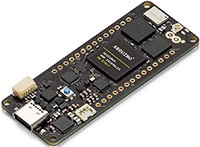Portenta H7
Arduino’s Portenta H7 simultaneously runs high-level code along with real-time tasks
 Arduino's Portenta H7 has a processor with dual-core STM32H747 that includes a Cortex®-M7 running at 480 MHz and a Cortex-M4 running at 240 MHz. The two cores communicate via a remote procedure call mechanism that seamlessly allows calling functions on the other processor. Both processors share all the on-chip peripherals and can run Arduino sketches on top of the Arm® Mbed™ OS, native Mbed applications, MicroPython/JavaScript via an interpreter, and TensorFlow™ Lite.
Arduino's Portenta H7 has a processor with dual-core STM32H747 that includes a Cortex®-M7 running at 480 MHz and a Cortex-M4 running at 240 MHz. The two cores communicate via a remote procedure call mechanism that seamlessly allows calling functions on the other processor. Both processors share all the on-chip peripherals and can run Arduino sketches on top of the Arm® Mbed™ OS, native Mbed applications, MicroPython/JavaScript via an interpreter, and TensorFlow™ Lite.
The onboard wireless module allows users to manage Wi-Fi and Bluetooth® connectivity on the Portenta H7 simultaneously. The Wi-Fi interface can be operated as an access point, station, or dual-mode simultaneous AP/STA and can handle up to 65 Mbps transfer rate. The Bluetooth interface supports Bluetooth classic and BLE.
The Portenta H7 complies with the Arduino MKR form factor but is enhanced with the Portenta family's 80-pin, high-density connector. The Portenta family adds two 80-pin high-density connectors at the bottom of the board. This ensures scalability for a wide range of applications by upgrading the Portenta board to suit users’ needs.
- Multiple options in one module:
- STM32H747 dual-core processor
- 8 MB SDRAM
- 16 MB NOR Flash
- 10/100 Ethernet PHY
- USB HS
- Secure element
- Wi-Fi/BT module
- UFL connector
- DisplayPort over USB-C®
- Main processor: STM32H747XI dual Cortex-M7+M4 32-bit low power Arm MCU
- SDRAM: 8 MByte to 64 MByte option
- QSPI Flash: 2 MByte to 128 MByte option
- Ethernet: 10/100 PHY option
- Wireless: BT5.0 + Wi-Fi 802.11 b/g/n 65 Mbps option (Portenta H7 only)
- Secure element: ECC608 or SE050C2 (common criteria EAL 6+) option
- Display connector: MIPI DSI host and MIPI D-PHY to interface with low pin count large displays (Portenta H7 only)
- GPU: Chrom-ART graphical hardware Accelerator™
- Timers: 22x timers and watchdogs
- UART: 4x ports (two with flow control)
- SD card: Interface for SD card connector (through expansion port only)
- Operational temperature range: -40°C to +85°C
- Power: Through USB-C connector or LiPo battery (integrated charger)
- Current consumption: 2.95 µA in standby mode (backup SRAM off, RTC/LSE on)
- USB-C: Host/device, DisplayPort out (Portenta H7 only), high/full speed, and power delivery
- MKR headers: Use any of the existing industrial MKR shields on it
- High-density connectors: Two 80-pin connectors will expose all of the board's peripherals to other devices
- ESLOV connector: Arduino's open connector standard for self-identifiable hardware
- Camera interface: 8-bit, up to 80 MHz (Portenta H7 only)
- ADC: 3× ADCs with 16-bit max. resolution (up to 36 channels, up to 3.6 MSPS)
- DAC: 2× 12-bit DAC (1 MHz)
- High-end industrial machinery
- Laboratory equipment
- Computer vision
- PLCs
- Industry-ready user interfaces
- Robotics controllers
- Mission-critical devices
- Dedicated stationary computers
- High-speed booting computation (ms)
Portenta H7
| Image | Manufacturer Part Number | Description | Available Quantity | Price | View Details | |
|---|---|---|---|---|---|---|
 |  | ABX00042 | PORTENTA H7 | 378 - Immediate | $929.25 | View Details |










